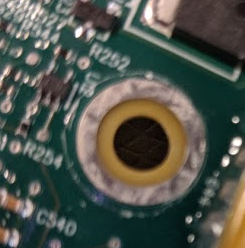Inspecting Parylene Coating
Posted by Sean Horn
Friday, April 13, 2018 7:30
@ 7:30 AM
Parylene conformal coating (XY) provides insulative protection for complex electronic circuit assemblies expected to function through rigorous operating conditions — potential chemical, electrical, moisture and vapor incursion during performance. Applied through chemical vapor deposition (CVD), parylene penetrates deep within substrate surfaces, generating a level of assembly security surpassing that offered by liquid coatings such as acrylic, epoxy, silicone and urethane. Yet, although XY is applied in a vacuum, it’s capacity to provide these extraordinary qualities does not exist in one. Parylene’s durable protective value depends on film adhesion, a quality subject to persistent, thorough inspection throughout the production process.
Diamond MT’s parylene services include coating provision for clients’ printed circuit boards (PCBs), medical devices, and similar products, shipped to our production facility. The incoming inspection process begins immediately after items awaiting parylene coating have been unpacked:
- Received assemblies are counted to verify quantity in comparison to the client’s provided packing slip/purchase order.
- Damage-inspection verifies assemblies arrived at our facilities without breakage or defacement.
Individual processing follows these procedures, with additional inspection and cleanliness testing. This is imperative; substrate contaminants may have accumulated during manufacture, handling and transportation. Without question, the most significant factor affecting parylene (or any conformal coating) adhesion is surface cleanliness; contaminated surfaces lead to poor coating quality, limited adhesion, and delamination, defeating the purpose of XY application. To this degree. cleanliness inspection is a vital step in the coating process, assuring the substrate surface is ready to accept parylene conformal coating without incident.
Visual inspection alone is insufficient to confirm a PCB’s suitable cleanliness and other stage-readiness for XY coating. Throughout the production-run, every phase of the process must be consistently measured and monitored; this ongoing performance inspection averts costly cleaning issues. At Diamond, we maintain a sampling process throughout each production run, designed to:
- confirm the readiness of a customer’s assemblies for parylene coating, per IPC-J-STD-001 stipulations,
- ensuring consistent quality levels throughout XY coating procedures.
According to IPC-J-STD-001 specifications, surface cleanliness levels should register 10µgm NaCl/in2 or less. Diminishing adherence to this standard is inadvisable; doing so jeopardizes coating and assembly performance. Substrate contamination undetected prior to film application requires process-cessation, and substrate recleaning, until acceptable non-contamination levels are achieved. These costly missteps are avoided by appropriately implemented cleanliness inspection before XY application is commenced.
XY inspection for quality assurance also details the degree of the coating thickness necessary to meet assignment specifications, PCB-area of coverage, visual, and adhesion-testing requirements. Subject to intensive inspection and evaluation, micron-thin XY-films are constructively measured:
- using spectral reflectance directly on components or
- by comparing project film-application with witness coupons previously XY-coated to ascertain similarity of result.
 Quality attributes for parylene typically specify the use of various inspection procedures that verify appropriate surface purity. These include:
Quality attributes for parylene typically specify the use of various inspection procedures that verify appropriate surface purity. These include:
- Ionic Exchange Chromatography (IEC), for identifying the presence of inorganic substances like chloride, fluoride, potassium and sodium. Specifying contaminants, IEC aids in selection of appropriate solvent/cleaning systems to resolve the issue.
- Fourier Transform Infrared Spectroscopy (FTIR) denotes the presence of specific organic contaminants, like mold agents or silicon oils.
- Gas Chromatography can also detect/identify surface organic contaminants; sometimes used in conjunction with Mass Spectroscopy, when more complex contaminants are detected.
Once cleaning has been enacted, masking processes assure parylene coating doesn’t penetrate assembly keep-out areas, in accordance with client specifications. Subsequent masking inspection verifies compliance, leading to implementation of CVD procedures (the coating process). After XY deposition, masking materials are removed, and the batch is subject to further inspection, to assure even, pinhole free coating without tears along formerly masked regions. Thickness inspection verifies appropriate film thickness has been achieved.
Prior to packaging coated assemblies, final inspection is necessary. Encompassing every aspect of the product, this process ensures
- successful implementation/completion of all phases required by the specific XY coating assignment, and
- absolute compliance with the client’s drawings and specifications.
After passing final inspection, assemblies are ready to ship. At Diamond, return-to-client typically takes about ten business days, but faster turn-around can be negotiated at your request.
To learn more about parylene coating inspection, download our whitepaper now:
Download our guide on Parylene 101
Comments
Homepage 4/17/2020. 10:17:10 AM
... [Trackback] [...] Informations on that Topic: blog.paryleneconformalcoating.com/whats-the-difference-between-potting-and-conformal-coating/ [...]

londondrugscanada.bigcartel.comlondon-drugs 4/17/2020. 10:17:10 AM
cialis uk https://londondrugscanada.bigcartel.com/london-drugs This is nicely expressed. !